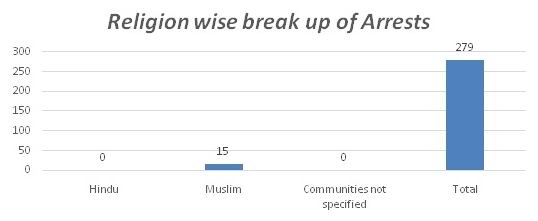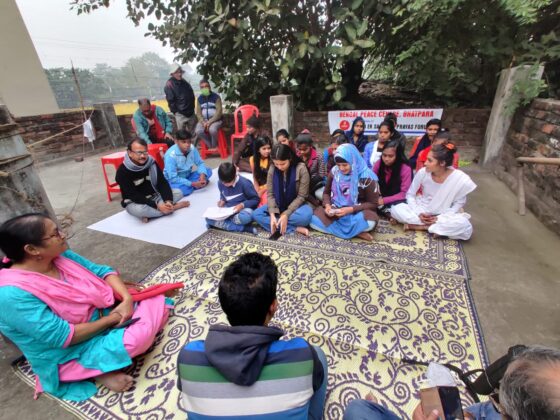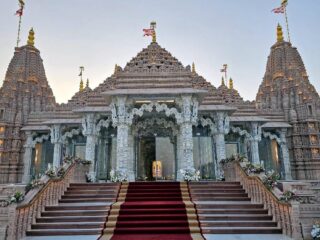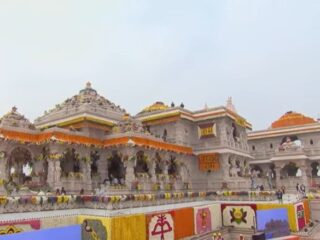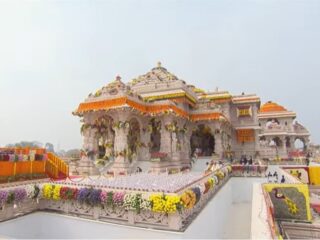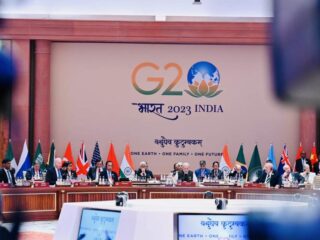Irfan Engineer and Neha Dabhade
The previous part of CSSS report on communal violence 2021 focused on the politics of heritage and the increasing state spending on promotion of Hindu iconography in different forms in 2021. It was argued that this promotion of Hindu iconography by the state to the exclusion of other religions is one form of communal violence and the most prominent form of communal violence in 2021. The other aspect of communal violence is physical violence which manifests in the communal riots, mob lynching and hate crimes. In this part of the report, the trends in communal riots, mob lynching and hate crimes in 2021 will be discussed in details.
Communal riots:
According to the monitoring of Centre for Study of Society and Secularism, based on the reportage of Mumbai edition of The Hindu, Indian Express, Times of India, Shahafat and Inquilab, there were 21 communal riots in 2021. This monitoring is by no means exhaustive; it is based on the monitoring of only five abovementioned newspapers. The year 2020 saw ten communal riots based on the monitoring of CSSS following the same methodology. More comprehensive reports based on access to more substantial sources peg the communal riots at much higher number. According to National Crime Records Bureau (NCRB) data, communal riots registered an increase of 96% in 2020 over the previous year- 438 in 2019 and 857 in 2020. CSSS monitoring showed 25 riots in 2019 and 10 in 2020.
From the available numbers mentioned in the reportage of the above five newspapers, CSSS could arrive at the number of arrested and injured in the 21 communal riots. These twenty one (21) communal riots in 2021 claimed one life, a Hindu man and injured 60. Out of the 60 injured, 23 were police personnel, 3 were identified as Muslims, and 2 were identified as Hindus and rest were unidentified. A total of 279 were arrested and in addition 300 more persons were booked under different sections. Out of 279 arrested, 15 were identified as Muslims and others are unidentified. The communal riots also witnessed damage in terms of property- public property including government and police vehicles, mosques and private property mostly belonging to the Muslims.
The conspicuous aspect emerging from the observations of communal riots in 2021 is the aggressive rallies or yatras– Shourya yatras to collect donations for construction of Ram temple in Ayodhya or protest rallies that were organized by Hindu nationalists including VHP, Bajrang Dal and Hindu Jagran Manch. These organizations from the last few years, have brazenly with or without permission from the state, without fear mobilized large number of crowd with arms and deliberately chosen to take the rallies in Muslim majority or mixed areas to instigate and humiliate the Muslim community. During these rallies, slogans are raised against Muslims almost instigating them. The state’s official position most of the time claims that Muslims pelt stones at the rally and thus arrested the Muslims in large numbers majority of cases. Very little action is taken action those who organize these rallies. In effect, the Muslims are victimized on two counts- their houses, mosques and shops are damaged, people injured and they are also criminalized by slapping cases against them despite the damages they suffer. In 2021, two of the yatras had direct political patronage and involvement of BJP leaders- in Kadirdham, leaders from the opposition BJP including former MLA Abhishek Singh, who is the son of former chief minister Raman Singh, flagged off the protest and in Amravati, BJP called for the protests against the rally organized by Raza Academy. Out of 21 communal riots, 12 riots have involvement of right wing Hindu nationalists’ organizations.
Geographical mapping of communal riots:
20 communal riots in 2021 took place in the seven states of Maharashtra, Tripura, Telangana, Chhattisgarh, Madhya Pradesh, Rajasthan and Gujarat. Out of these seven states, three are ruled by BJP and three by Congress. Alternatively, 12 communal riots of out 20 have taken place in states ruled by BJP and 8 in Congress ruled states. Every year, the northern part of India and Uttar Pradesh in particular is a hotbed communal violence. As seen above, communal violence in Uttar Pradesh is manifesting itself in the form of repressive laws, biased implementation of laws and intense heritage politics. Thus, though no riots were reported in the media reportage referred to in this monitoring; there is heightened polarization, hatred and number of hate speeches from UP. However, the riots that taken place in rest of north India as per our monitoring stands at nine (10)- seven in Madhya Pradesh, two in Rajasthan and one in Chhattisgarh, three (3) in Eastern India in Tripura and seven (7) in Western India- five in Maharashtra and two in Gujarat and one in the south in Telangana. Madhya Pradesh has also been in news for attacks on Christians, pastors and Churches. Madhya Pradesh and Gujarat ironically also passed the Freedom of Religion Acts under which Muslims and Christians have been arrested.
| State | Number of Communal Riots |
| Madhya Pradesh | 6 |
| Maharashtra | 5 |
| Tripura | 3 |
| Rajasthan | 2 |
| Gujarat | 2 |
| Chhattisgarh | 1 |
| Telangana | 1 |
| Total | 20 |
Triggers for communal riots:
Madhya Pradesh has emerged as a hotbed of communal riots. Ironically, at the end of 2020, Madhya Pradesh had witnessed major communal riots in Indore, Ujjain and Mandsaur. The Muslims had sustained heavy damages to their property due to the riots triggered by yatras organized by Hindu nationalists groups to collect donations for the construction of Ram temple in Ayodhya. In 2021 too, the riots in Madhya Pradesh speak volume about the emboldened Hindu nationalists asserting their supremacy. In Manawar in Dhar district of Madhya Pradesh, the VHP along with other allied organizations took out the “shourya” yatra Muslim inhibited areas on 23rd December, 2021. The yatra had around 5000 participants with DJ music. The police claimed that Muslims from the Muslim locality and the mob from the yatra clashed and communal riots ensued. However, if the two communities clashed as per the police version then both the communities were involved in violence, but only Muslims were arrested- 12 arrested and over 30 booked by the police. The administration also razed down a three storey building of building of 55-year-old Khalil Khatri. The administration argued that three accused in the riots were living there on rent and that the owner didn’t have permission for the building.
In another instance of communal riot, in Neemuch, MP, a Muslim shrine was vandalized and the caretaker of the Bhedabhan shrine along with two devotees were tied up and beaten up in October. Explosives were used to damage the shrine. Twenty odd unidentified persons attacked this shrine citing alleged conversions. Charges are pressed against unidentified persons. The rest of the five riots in MP took place during the observing of Eid-i-milad un-nabi at five places- Dhar, Jabalpur, Barwani, Khargone and Sendhwa. In Barwani, it is alleged that the Muslims were playing “objectionable” songs during the procession which enraged the Hindu community and pelted stone. Six members from both communities got injured. In Jabalpur, the police when tried to stop the procession, the Muslims allegedly threw fire crackers at the police. Six police personnel were injured. The police used teargas and batons on the mob. In Dhar, the procession took another route than that was finalized earlier by removing the police barricades. Police alleged that some participants from the procession threw stones at them following which they carried out a lathi charge to disperse the crowd. In Khargone, 5 persons were injured when riot broke out over removal of a religious flag after the procession. Two cross FIRs were filed and 36 arrested. In Sendhwa, the police booked over 20 persons who allegedly took out the procession despite the prohibitory orders were in place.
In Kabirdham in Chhattisgarh, communal riots were triggered off by a protest rally called for by the BJP and flagged off as mentioned above by the leaders from the opposition BJP, including former MLA Abhishek Singh, who is the son of former chief minister Raman Singh. A 3000 strong mob headed by VHP and Bajrang Dal raised slogans of Jai Shri Ram, attacked homes and vehicles owned by Muslims, and pelted the police with stones. More than a dozen civilians and police personnel were injured in the violence. The organizers defied a curfew put in place by the administration. A mob of mostly young men entered Muslim neighbourhoods and began attacking vehicles, handcarts, and doors and windows of houses. The protest was called against alleged beating up of a local history- sheeter by a group of Muslims. A few hours later there was an altercation between two groups over pulling down of flags and alleged stone pelting at a temple.
In Bhainsa town of Telangana, communal riots took place over a spat between two groups of youth belonging to two different communities. One duo was on a motorcycle and hit the other youth who was walking with friends. This spat resulted in stone pelting from both communities and 12 persons including three police personnel got injured. During the violence, according to police, four houses, thirteen shops, four auto rickshaws, six four-wheelers, and five two-wheelers were set ablaze in the Panjesha Masjid area, Korba Gully, Cloth Merchant Road, Purana Bazar, and Market Road areas by the rioters. It is alleged that one group was guided by Abdul Khabeer alias Baba, AIMIM party’s Counsellor and other by Thota Vijay, Counsellor and ex-president of Hindu Vahini. 38 persons, belonging mostly to Hindu Vahini were arrested and the involvement of another 70 was established according to the police. Bhainsa is emerging as one of the hotbeds of communal riots. In 2020 too, Bhainsa had witnessed a communal riot. In 2008, it had witnessed a major communal riot. This town is deeply polarized along religious lines by leaders of both communities leading to uneasy tension.
In Gangdhaar town of Jhalawar district in Rajasthan, communal riot took place over a spat between youth of two communities. But the situation escalated when a provocative message went viral on social media stating that people from one of the communities were being attacked and thrashed in Gangdhar calling upon them to assemble at a spot. Subsequently mob gathered from both the communities and there was stone-pelting. The mob burnt wooden stock, a couple of cabins, damaged government property and set a few vehicles on fire. In another incident in Rajasthan, in Baran district as a result of a spat between two groups belonging to two different communities, two Hindu youth were stabbed. Subsequently two groups clashed. Police used tear gas to disperse the violent crowds but members of two communities, armed with sticks, iron rods and weapons, setting ablaze a fire tender and damaging public property including police and government vehicles.
In Gujarat, riots took place in two places- Kidana in Kutch and Somnath. In Kidana, a “rath yatra” was organized by the Vishwa Hindu Parishad without the required permission to collect funds for the construction of the Ram temple in Ayodhya. Violence broke out when loud religious slogans were raised as the rath passed a mosque that provoked another community. It led to stone pelting, arson and violent attacks with swords and sticks. In the violence that ensued one migrant worker from Jharkhand Arjun Manki Sovaiya died of stab wounds. Forty persons were arrested on charges of murder, rioting, arson, conspiracy and violation of section 188 of IPC (disobedience to order duly promulgated by public servant) among others, in all the three cases. In another incident of communal riot in Somnath, there was a collision of two fishing boats in a jetty in Nava Bandar village in Una taluka which led to a clash between two communities. Six policemen and around a dozen other people got injured in the violence.
In 2021, three riots took place in the state of Tripura in the north east India. This violence was related to the vandalism of temples and attacks on Hindus during Durga Puja in Bangladesh over allegations of blasphemy arising out of a post on social media. In protest against the vandalism in Bangladesh, rallies were taken out by organizations like the Vishwa Hindu Parishad (VHP) and the Hindu Jagran Manch (HJM), among others in different parts of Tripura- Panisagar, Dharmanagar and Agartala. During some of these protest rallies, several houses, shops and mosques were vandalized and Muslim establishments targeted. The administration denied that mosques were burnt and came down heavily on journalists and civil society organizations who were reporting from the ground.
The riot in Amravati was connected to the violence in Tripura where Muslim organizations organized a march in Amravati which turned violent. The Raza Academy had given a call for the Muslim community to protest in Maharashtra against the riots in Tripura. In the past, Raza Academy is known to have taken hard line positions on issues concerning Muslims and Islam. Raza Academy mobilized a large gathering of Muslims which went out of control and targeted Hindu establishments. A few participants from the march allegedly stormed and ransacked Hindu shops. After this was captured on CCTV cameras and these clips were circulated, the local BJP unit called for a bandh and mobilized a mob of thousands. The mob vandalized two dargahs and shops owned by Muslims. Shops were set on fire. Losses were suffered by Hindus and Muslims alike. A total of 113 people were detained in 10 police station jurisdictions. Among those arrested is BJP leader and former state minister Anil Bonde.
Role of Right Wing supremacist Organizations:
There is presence of right wing organizations in almost all the 21 incidents of communal riots. Communal riots were initiated or instigated by right wing organizations like Vishwa Hindu Parishad, Hindu Vahini or Bajrang Dal or participated by in the riot, fanning it further. Examples of where communal riots were started by VHP or Hindu Jagran Manch are in Tripura. A rally was taken out by these groups to instigate and mobilize the Hindus by playing up the violence against Hindus in Bangladesh and polarizing along religious lines. The participants of this rally vandalized establishments belonging to Muslims and allegedly mosque. In Maharashtra too, after the riots instigated by Raza Academy, the VHP exploited the violence and called for a rally to avenge leading to prolonged violence in five places in Maharashtra. In fact Anil Bonde, a BJP leader played a major role in the riots.
In Kidana, riots were orchestrated by VHP when it organized a Rath yatra for collection of donations for the construction of ram temple in Ayodhya. In Kabirdham, Chhattisgarh too the VHP and Bajrang Dal organized rally and amidst aggressive sloganeering of “Jai Shri Ram” where Muslim establishments were targeted. BJP leaders too were involved and their role is recorded in newspapers and CCTV cameras.
In Manawar, Madhya Pradesh organized Shourya Yatra where the Hindutva groups led a rally in a Muslim dominated area and played loud music. They targeted Muslim households. Similar incident had taken place in December 2020.
Role of State:
The police in the communal riots have been facilitating rioters or being silent spectators. The police have reacted too late and too little to protect the innocent citizens and their property. Even in terms of bringing the culprits to justice, it is seen in most of the cases, that the Muslims who are victims in most of the riots suffering losses by way of injuries and damage of property are also slapped with cases related to rioting. The participants in the aggressive rallies and associated with the Hindutva organizations are not taken action against and enjoy impunity, often the police pretend that the participants in these rallies are unidentified. This argument of the police is ironically is baffling given that the videos of the rallies and attacks often are circulating on social media. Cases are registered against “unidentified” persons despite of availability of evidence- sheltering the members of the right wing groups.
The disturbing trend from 2020 where houses belonging to Muslims were demolished in Ujjain and Indore by the administration, continued in 2021 too. In the riot of Manawar, the district administration razed the three-storey building of 55-year-old Khalil Khatri to the ground. The property is worth over Rs 45 lakhs. Police said that three of the accused were living there on rent and the owner had allegedly failed to produce building permission within fewer than 24 hours of serving notice. Madhya Pradesh also passed the MP Damage to Public and Private Property Recovery Bill, 2021, which enables recovery of public and private property damaged during the riots, protests and rallies by individuals or groups within 15 days of a tribunal’s verdict.
It appears that the state is complicit in the riots by allowing the aggressive rallies despite having adequate precedent of such rallies leading to communal riots. The state is giving impunity to the Hindutva organizations to instigate and orchestrate riots openly by humiliating Muslims and exhibiting naked show of strength and domination. While till 2014, mostly riots were orchestrated in a more veiled manner and attributed to “fringe elements”, post 2014, the political leaders and hard line organizations are openly and directly instigating riots, complacent in the knowledge that the state will take little action against them.
Mob Lynching:
In 2021, there were a total of 15 incidents of mob lynching in India and loss of 11 lives- 7 Muslims, 3 Hindus and 1 unidentified victim. From these 15 incidents, 4 incidents were related to cow slaughter, two were related to accusations of “love jihad” and two more on the suspicion of theft. Two incidents were related to accusations of sacrilege or desecrations of the Guru Granth Sahib. Four incidents constitute as hate crimes- lynching only on account of the religious identity of the victim.
Out of the total 15 incidents, three incidents of mob lynching took place in Madhya Pradesh, two in Rajasthan, two in Uttar Pradesh, two in Punjab, one each in Haryana, Delhi, Tripura, Bihar, Chhattisgarh, Karnataka and Maharashtra.
| State | Mob Lynching Incidents |
| Bihar | 1 |
| Chhattisgarh | 1 |
| Delhi | 1 |
| Haryana | 1 |
| Karnataka | 1 |
| Madhya Pradesh | 3 |
| Punjab | 2 |
| Rajasthan | 2 |
| Tripura | 1 |
| Uttar Pradesh | 2 |
| Grand Total | 15 |
Role of the State:
The state is taking little or no action against vigilante groups which is emboldening them to target innocent without fear. The pretext often used is cow slaughter and smuggling. The state by undertaking protection of cows and ambulance services for cows directly encourage vigilantes to do anything to “protect” cows. Though the victim is lynched under this pretext, he/she is denied justice and slapped with laws protecting cows. In the incident in state of Tripura, two cases were filed, one against “cattle smugglers” and other for mob lynching. In this incident four people- all Muslims were lynched brutally by cow vigilante group.
Hate Crimes against Christians:
Expressing concern on the spate of attacks on Christians in India, Kerala Chief Minister Pinarayi Vijayan in his speech in the beginning of the year said that in 2021 there were 478 attacks on Christians as opposed to 142 incidents of attacks in 2015. He was quoting data from the Delhi-based United Christians Forum. This statement reflects the magnitude of the violence faced by Christians- through non-state actors like vigilante groups and on account of anti-conversion laws passed by various states in India. The hate speeches by elected representatives are acting as fuel in the unabated attacks where little action is taken against the wrongdoers. The Christians face intimidation from vigilantes who without fear of law attack the community members, vandalize churches and disrupt prayer meetings. The attacks against Christians have intensified after the passing of the so-called freedom of religion acts in the states like Madhya Pradesh and Karnataka.
The vigilante groups have gone in an overdrive to witch hunt innocent citizens under the pretext of religious conversion. For instance, Akhila BharathaVeerashaiva Mahasabha has asked its units to report any case of conversion of its members and prepare for ‘ghar wapsi’ to bring such people back into the fold. The letter dated November 15, 2021, has asked office-bearers to be in constant touch with religious mutts. Programmes should be framed to bring those people ‘who were trapped under pressure’, the letter says, adding that it is a matter of grave concern that some community members have been ‘induced to convert’ to other religions, such as Christianity (The Hindu, 2021)
The state has also as stated policy is banning conversions and criminalizing pastors or organizations alleging conversions. The Home Ministry recently rejected renewal of FCRA of organizations run by Christian missionaries. FCRA is being used to target Christian organizations alleging conversions. “Complaints have been received against 18 FCRA-registered NGOs in Andhra Pradesh regarding their alleged indulgence in conversion to Christianity through “inducements, allurement and misrepresentation” since 2018”, Union Minister Nityanand Rai said in Lok Sabha (The Print, 2021).
According to a report by human rights group, PUCL, 2021 saw 39 incidents of hate crimes against Christians in Karnataka (PUCL, 2021). This number is indicative of the scale of violence against Christians in the state. The media reports referred to by CSSS have described some of the hate crimes in Karnataka. For instance, a group of Bajrang Dal activists allegedly disrupted a prayer meeting at Jesus Prayer Hall in Belur, Karnataka on the ground that “forced religious conversions” (G.T, 2021). In another incident in Karkala, Karnataka, members of Hindu Jagaran Vedike disrupted a prayer meeting of Christians alleging religious conversions (Times of India, 2021). In Srinivasapura in Kolar district of Karnataka, right-wing groups attacked four members of the Christian community and set their religious books on fire on allegations of forced conversions (Parashar, 2021)’.
The bogey of conversion got its strongest voice when BJP Hosadurga MLA Gulihatti Shekhar alleged that over 20,000 people of his constituency had been converted to Christianity along with his mother. He conducted a ‘ghar wapsi’ programme of eight families, including his 72-year-old mother, and all converted back to Hinduism (The Indian Express, 2021). However his alleged were debunked by an inquiry report which probed into these conversions. A group of Hindu locals from Hanumanapalya in Kolar’s Srinivaspur burnt religious books which were reportedly being distributed by members of the Christian community (Times of India, 2021).
Similar incidents have taken place in the state of Madhya Pradesh. A senior secondary school run by the Syro-Malabar Church in Madhya Pradesh’s Satna district sought protection from police following an “ultimatum” by the VHP and Bajrang Dal to “reinstall” an idol of Saraswati, which they had claimed had been removed from the premises (Siddique, 2021). In another incident, members of a pro-Hindutva organisation held a protest in front of St. Joseph School alleging the school of carrying out religious conversion of eight students in Vidisha district. The Bajrang Dal and Vishwa Hindu Parishad aggressively pushed for action against the accused (Dutta, 2021). In Chhattisgarh, two pastors were attacked in a police station by a mob alleging forceful conversions being conducted by the Church. A complaint was filed against the pastors by right wing groups accusing them of conversions.
Christmas marred by incidents of Vandalism:
There were calls given by Hindu vigilante groups to all to not celebrate Christmas in Assam and Haryana. Christmas in 2021 was also marked by vandalism and violence at some places. Two intruders vandalised Holy Redeemer church in Ambala early on 26th December, 2021 and allegedly desecrated the Christ statue there. 53 people from 13 families of tribal got converted to Hindusim on Christmas day. On December 25, the Paithan Brahmin Sabha reportedly held a religious ceremony at the Nath temple in Paithan, Aurangabad, where the alleged conversions to Hinduism were held. Christian organisations have raised concerns over the incident, claiming that Christmas Day was chosen for the event only to hurt the sentiments of the Christian community. Miscreants vandalised an idol of St. Anthony and idol of Jesus at the grotto of St. Anthony’s church at Soosaipalya in Chickballapur in Karnataka (The Hindu, 2021).
These hate crimes are not limited to Christians alone. In Haryana, Hindu right wing organizations mounted vicious protests against Muslims offering Namaz on government owned lands and went as far as spreading cow dung on a prayer site. On other occasion, the slogans of ‘Jai Shri Ram” were raised at prayer sites when Muslims were peacefully offering namaz. Subsequently, the Gurgaon administration announced that Muslims could not pray at eight of the 37 previously agreed sites. This policy of the Haryana government and giving a free hand to the Hindu right wing signifies the exclusion of Muslims from public spaces.
Conclusion:
Communal violence weakens the very foundation of democratic institutions. Communal riots have led to polarization and tensions on the ground between communities co-existing for many years. It directly vitiates the social atmosphere and strains the social fabric. However, what is far more dangerous and in to that extent long lasting is the polarization and hegemony brought about by legislations and policies. The creeping of Hindu iconography in public spaces and policies is unmistakable. It mocks at the principle of secularism enshrined in our constitution. The hate speeches which reflects complete lack of fear of law and also lack of moral responsibility on part of state and non-state actors has led to a atmosphere of free for all to spew venom and call for violence against the fellow citizens of this country. This trend if continues to grow has the potential to do irreversible damage to the democratic and secular ethos of India.

